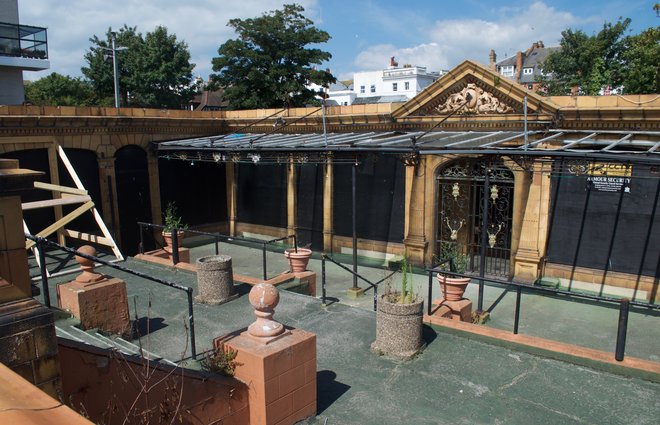Former Edwardian tea rooms/theatre/snooker hall with Art Nouveau windows seeks long term future

National architecture charity the The Victorian Society has included Leas Pavilion in Folkestone on its 2017 Top 10 Endangered Buildings list. The Top 10 campaign, now in its tenth year, recognises the plight of endangered Victorian and Edwardian buildings in England and Wales in the hope that increased publicity will help save them.
The Grade II-listed Leas Pavilion on the Folkestone coast first opened as a high-class tearooms in 1902. Due to an “Ancient Lights” clause in the leases of the hotels on either side, no building could be erected more than 7ft above street level to ensure no daylight would be blocked from these buildings. A local architect, Reginald Pope, therefore designed a building below ground level.
The Pavilion has a striking terracotta frontage, made by the Doulton Company, finished with art nouveau styled windows. Up to 450 diners were accommodated on the best oak and walnut floor. The entertainments proved very popular and in 1906 a small stage was added and concert parties were introduced.
Later in the 20th century it was further converted into a theatre until its eventual closure in 1985 when it became a snooker hall. This then closed in 2007 and the building has remained empty ever since. Planning permission for an apartment block that would be built over the top of the Pavilion was granted in 2015, but no work has started other than some urgent works for the building’s immediate safety. An active local group continues to campaign for its survival, but its situation as a building at risk remains critical.
Christopher Costelloe, The Victorian Society Director, said: “This charming Edwardian pavilion on the Kent coast has marvellous potential as a community space, and it’s a crying shame that hasn’t been realised for so long. The community group currently campaigning for its restoration are doing a laudable job at generating local awareness and raising funds, but the long-term future of this building can only be safeguarded with a sensitive restoration to bring it back into the community where it belongs.”